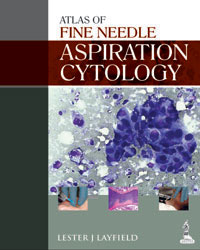|
|
|
| |
 |
|
|

|
 推薦指數:
推薦指數:





|
|
- 內容介紹
|
Atlas of Fine Needle Aspiration Cytology
Author:
Lester J Layfield MD FASCP
ISBN 9789351521112
Edition 1/e
Publish Year 2014
Pages 392
Size 8.5" X 11"
Cover Type Hard Back
Quick Overview
Diagnostic approach and technical methodology for the diagnosis of neoplastic disease has undergone considerable advancement in the last decade. The rise of a multidisciplinary approach to the diagnosis and treatment of oncological diseases along with the development of so-called “personalized medicine” has markedly increased the use of small biopsy techniques, including fine needle aspiration. Advances in cytology, immunocytochemistry, and molecular techniques have allowed FNA and small core biopsies to yield diagnostic material along with sufficient material for prognostic and predictive studies. Hence, fine needle aspiration has become a popular and effective initial technique for the workup of most newly discovered nodules and masses suspected to be of neoplastic origin. Fine needle aspiration coupled with rapid on-site evaluation allows for triage of limited specimens to appropriate diagnostic, prognostic and predictive testing. The initial cytologic evaluation is paramount in this diagnostic approach. Fine needle aspiration cytology often coupled with mini-core needle biopsies prepared as cellblocks has become the standard of practice in the workup of potentially neoplastic lesions. Once the diagnosis of malignancy is obtained, material can be set aside for immunocytochemistry, electron microscopy, flow cytometry, fluorescence in situ hybridization analysis and molecular technologies often based on polymerase chain reaction methodologies. Using this approach, all necessary diagnostic and predictive data can be obtained with minimal morbidity for the patient and at a relatively low price.
The present atlas is designed to illustrate all common neoplastic lesions samplable by fine needle aspiration throughout the body. These lesions are richly illustrated and described in the text. Key features are listed in tabular form and differential diagnoses are discussed. Additionally, a large number of uncommon or rare neoplasms are illustrated and discussed. For the more common lesions, ancillary diagnostic techniques are discussed, including molecular techniques when relevant. Each chapter approaches its organ system with a uniform format. When a given neoplasm occurs in more than one organ system, it is discussed and illustrated in the relevant chapters and crossreferenced. Every attempt has been made to abundantly illustrate the neoplasms most commonly encountered in a large fine needle aspiration cytology practice. Non-neoplastic entities are illustrated and discussed when they may present as mass lesions, enter the differential diagnosis of a neoplasm or may be encountered in oncologic patients.
Key Features
This atlas is designed to provide a concise and richly illustrated covering the more commonly encountered lesions in a routine fine needle aspiration practice as well as a significant number of rare lesions. The approach is practical and systematic for the diagnosis of these lesions. Key features are given as well as a discussion of the differential diagnosis. Importantly, a discussion of current ancillary techniques is given for each major lesion including immunocytochemistry and molecular techniques. The atlas is designed to be a practical, up-to-date and inclusive resource for both trainees and practicing cytopathologists.
|
|
|

